Asian Development Outlook (ADO) 2022 Supplement: Global Gloom Dims Asian ProspectsSouth Asia is projected to grow at 6.5% in fiscal year (FY) 2022 and 6.3% in FY2023. In Bangladesh, weak exports and high inflation are hampering recovery, while in Bhutan, agriculture and construction are projected to support economic growth. In India, growth is projected at 7.0% in FY2022 and 7.2% in FY2023, sustained by public reform and public and private investment. Maldives tourist arrivals and construction continue to pick up. In Nepal, the 2023 budget aims to improve agriculture, industry, and social protection. Economic contraction is expected in Sri Lanka with marked declines in industry and agriculture. In Southeast Asia, Myanmar maintains positive growth projections despite high rates of inflation. Author: Asian Development Bank Year: 2022 Download Tags: ADB, Agriculture, South Asia, Southeast Asia, Investment, Social Protection Key Indicators for Asia and the Pacific 2018This report presents the latest economic, financial, social, and environmental statistics for the 48 regional members of the Asian Development Bank (ADB). In 2017, foreign direct investment flows to developing Asia was stable, with 8.8% going to South Asia; energy gains were made in five of six countries in South Asia; and starting a business continues become easier in most developing ADB member economies following lowered regulatory costs and simplified compliance procedures. Nepal and Armenia experienced the most rapid annual growth rate at 7.5%, while India witnessed a 6.7% growth in GDP. Author: Asian Development Bank Year: 2018 Download Tags: ADB, Energy, Transport, Bangladesh, Bhutan, India, Maldives, Nepal, Southeast Asia, Sri Lanka Key Indicators for Asia and the Pacific 2017This report gives the latest statistics on economic, financial, environmental, and Sustainable Development Goal (SDG) indicators for the 48 regional members of the Asian Development Bank, including up-to-date figures on energy, trade, and transport. In 2016, Asia and the Pacific accounted for 40.9% of global gross domestic product (GDP). While foreign direct investment (FDI) flows declined in East Asia and Southeast Asia in 2016, FDI flows to South Asia remained stable. The average number of days required to start a business in South Asia was 16. Energy consumption is also expected to increase in the coming decades owing to increasing GDP per capita and an increase in the use of energy-consuming goods. Author: Asian Development Bank Year: 2017 Download Tags: ADB, Energy, Transport, Bangladesh, Bhutan, India, Maldives, Nepal, Southeast Asia, Sri Lanka 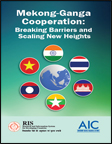 Mekong-Ganga Cooperation: Breaking Barriers and Scaling New HeightsThe Mekong-Ganga Cooperation (MGC) promotes intra-regional collaboration among Cambodia, India, Lao PDR, Myanmar, Thailand and Vietnam in the areas of trade, tourism, culture, education, and transport and communications. This book reviews how MGC cooperation has grown since MGC's inception in 2000, including expansion of their economic and cultural relations. Under India's Act East Policy, MGC has gained further momentum – endorsing a Plan of Action 2016-2018, and planning extended connectivity of the India-Myanmar-Thailand Trilateral Highway to Cambodia, Laos, and Vietnam. This report outlines important discussion points on trade, regional value chains, foreign direct investment, physical and digital connectivity, border connectivity, and cultural relations, to strengthen India and the Association of Southeast Asian Nation linkages through MGC. Author: Research and Information System for Developing Countries and ASEAN-India Centre Year: 2017 Download Tags: ASEAN, India, Southeast Asia, South Asia, Trade, Trade Facilitation Connecting Bangladesh: Economic Corridor NetworkEconomic corridors anchored on transport connectivity could significantly boost Bangladesh's economic growth. This paper presents a new set of corridors for Bangladesh – a nine-corridor comprehensive integrated multimodal economic corridor network that will enhance Bangladesh’s role as land bridge between South Asia and Southeast Asia, and between South Asia and northern Asia. These proposed corridors are designed to sustain robust economic growth over the long term by improving regional connectivity, transit, and integration, alongside trade facilitation measures. Author: Mohuiddin Alamgir Year: 2016 Download Tags: Economic Corridor, Bangladesh, South Asia, Southeast Asia, Connectivity, Transport, Trade Facilitation, ADB RCI 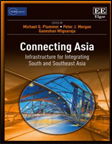 Connecting Asia: Infrastructure for Integrating South and Southeast AsiaThis book contains background papers prepared for the Asian Development Bank and the Asian Development Bank Institute joint study, 'Connecting South Asia and Southeast Asia.' It emphasizes the potential contribution to growth that greater connectivity—through better transport and energy infrastructure and improved soft infrastructure, including trade facilitation—between South Asia and Southeast Asia can foster. With benefits including greater participation in global supply chains for South Asia; lower trade costs; and increase in inter- and intraregional trade, the book underscores that, at a juncture where closer regional integration can secure sustainable and inclusive growth for economies in the two regions, specific policies should be examined and considered to enable both regions to maximize gains from greater integration. Author: Michael G. Plummer, Peter J. Morgan, Ganeshan Wignaraja, eds. Year: 2016 Download Tags: South Asia, Southeast Asia, Trade Facilitation, Transport, Energy, ADB, Economic Corridor, Bangladesh, India, Sri Lanka, ADB RCI Regional Transport Infrastructure: Mapping Projects to Bridge South Asia and Southeast AsiaThis Asian Development Bank (ADB) brief highlights the critical role of transport infrastructure in bridging South Asia and Southeast Asia. It maps details of economic corridors and highways, railroads, and seaports, and identifies priority transport investment projects needed to link the two subregions. While an investment of $986 million in road transport and $2.3 billion in sea ports may be needed to create proper connectivity between the two regions, the study's conservative estimate of potential benefit ranges from $89 billion to $358 billion over the next decade - demonstrating how investment in infrastructure can pay huge dividends in the medium- and longterm. Author: Peter Morgan, Mike Plummer, and Ganeshan Wignaraja Year: 2015 Download Tags: Transport, South Asia, Southeast Asia, ADB RCI Connecting South Asia and South East Asia This book analyzes how closer regional connectivity and economic integration between South Asia and Southeast Asia can benefit both subregions. It aims to build a broad case for increased connectivity between the two regions and identify specific projects that have high potential to fulfill this objective. This joint study focuses on both “hard” infrastructure and associated “soft” infrastructure, including tariffs and non-tariff barriers, trade and transport facilitation, energy trading, and infrastructure investment and financing. It further provides a canvas for considering strategic cross-border infrastructure investments and policy reforms. Author: Asian Development Bank Institute and Asian Development Bank Year: 2015 Download Tags: South Asia, Southeast Asia, Connectivity, Economic Corridor, Transport, Trade Facilitation, Bangladesh, India, Sri Lanka 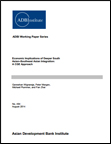 Economic Implications of Deeper South Asian–Southeast Asian Integration: A CGE ApproachHigh tariff and non-tariff barriers, and costly transport links and inefficient trade facilitation measures continue to hamper the growth of trade between South Asia and Southeast Asia. This paper explores whether potential gains from improved connectivity—via Myanmar as inter-regional bridge—justify a high level of investment. Using an advanced computable general equilibrium (CGE) model, reduction of inter-regional tariffs, decreasing of non-tariff barriers by 50%, and cutting down of trade costs between South Asia and Southeast Asia by 15% yields a prediction of 8.9% rise in welfare in South Asia and Southeast Asia, and an increase of 6.4% in gross domestic product by 2030. Author: Ganeshan Wignaraja, Peter Morgan, Michael Plummer, and Fan Zhai Year: 2014 Download Tags: Transport, Trade Facilitation, South Asia, Southeast Asia, Regional Integration, Tariff, Trade, Connectivity, Investment, Myanmar, GDP 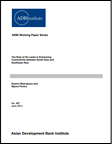 The Role of Sri Lanka in Enhancing Connectivity between South Asia and Southeast Asia As Sri Lanka rebuilds at the end of a 30-year conflict, its progress in improving physical infrastructure—including the Colombo port expansion and other programs for new expressways and road connectivity—has been significant. Yet, the country has seen a sharp decline in its overall exports-to-gross domestic product ratio. How Sri Lanka can benefit from greater connectivity with its neighbors in South Asia and Southeast Asia is discussed in this paper. Trade policies geared towards enhancing regional integration efforts could boost Sri Lanka's economy. Additionally, to lessen the challenges of financing and sustaining implementation of planned infrastructure development efforts, Sri Lanka could also implement a more stringent institutional and regulatory environment encouraging more private sector participation. Author: Dushni Weerakoon and Nipuni Perera Year: 2014 Download Tags: Trade Policy, Trade Facilitation, Sri Lanka, Connectivity, South Asia, Southeast Asia, ADB, Transport, Regional Integration 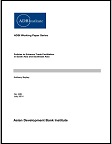 Policies to Enhance Trade Facilitation in South Asia and Southeast AsiaThis Asian Development Bank Institute publication identifies the state of play of trade facilitation and provides an overview of intra- and inter-regional trade in South and Southeast Asia. It highlights key challenges and bottlenecks to effective trade facilitation, ranging from the lack of expert human resources such as information technology specialists in small landlocked countries (Bhutan and Nepal), to the high border transaction costs and severe congestion faced at border crossing points, and the lack of effective dialogue on bilateral enhancement of trade facilitation. Regional initiatives such as the South Asia Subregional Economic Cooperation Program aim to address these challenges through customs modernization and harmonization, automation, and the use of international best practices in border procedures. Author: Anthony Bayley Year: 2014 Download Tags: South Asia, Trade Facilitation, Trade Policy, Southeast Asia, ADB, ICT, Bhutan, Nepal, SASEC, Customs |




